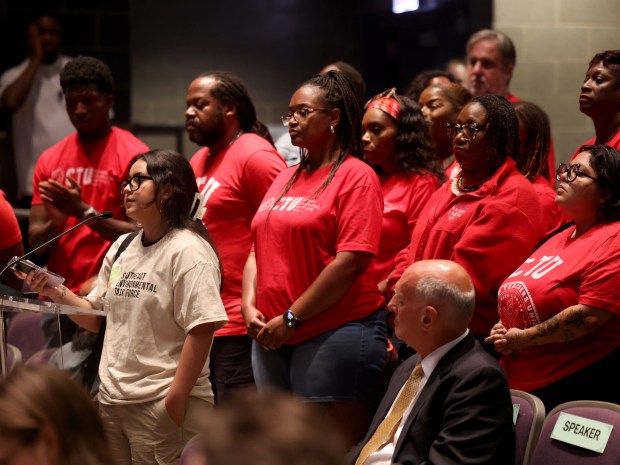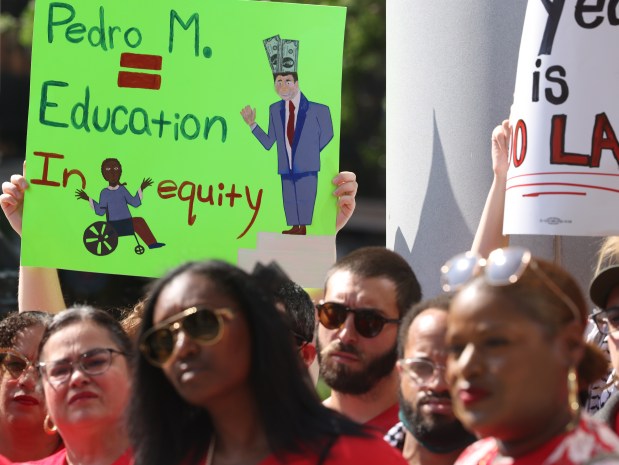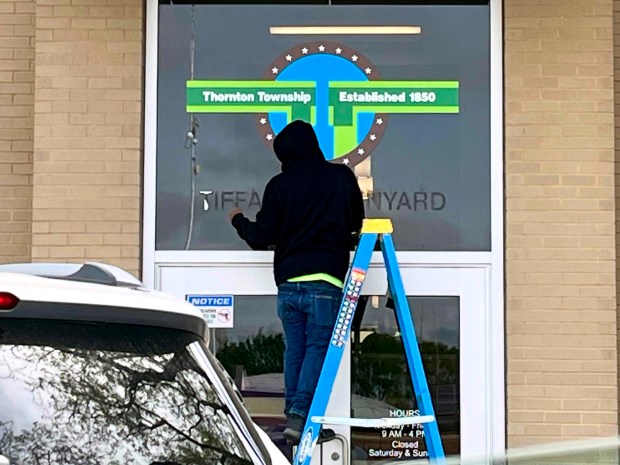Despite pressure from the teachers union to reject Chicago Public Schools’ proposed $9.9 billion budget, Board of Education members unanimously voted to pass the district’s spending plan for the 2024-25 school year Thursday.
But while the vote may have settled the debate over addressing CPS’ current $505 million deficit, the plan doesn’t account for future collective bargaining costs resulting from ongoing negotiations, with the approximately 30,000-member Chicago Teachers Union and the Chicago Principal Administrators Association of over 1,200 members.
With an amendment to address the cost of those contracts still on the horizon, tensions that arose in response to the initial budget proposal are unlikely to dissipate between CPS and Mayor Brandon Johnson’s administration and the Chicago Teachers Union.
The district did not address the Tribune’s request for an estimate of expected collective bargaining costs that a future budget amendment will need to resolve. In an analysis by the Civic Federation released Wednesday, the non-partisan government research organization estimated the cost of ongoing contract negotiations as $128 million, a figure also projected by the education nonprofit Kids First Chicago.
Separately, whether CPS is obligated to contribute $175 million to the city’s Municipal Employees Annuity and Benefit Fund remains in contention. “As the majority of the pensioners in MEABF are CPS employees, the City expects the Board to eventually amend its budget to account for the cost of that payment,” a Johnson spokesperson said Thursday.
A CPS spokesperson said the district will continue to work with partners to identify savings as well as additional revenue. The district, CTU and the Johnson administration have been unified in attributing the district’s underlying fiscal issues as a result of underfunding by the State of Illinois — which won’t be providing additional funds after finalizing its budget in July, Governor J.B. Pritzker’s office said in a statement to the Tribune. As for other solutions, CPS appears at odds with Johnson and the teachers’ union regarding a potential loan. Cuts in spending or property tax raises may be necessary, according to experts.
“There is no surplus in the budget that would accommodate allocating additional money to CPS,” said a spokesperson for the governor’s office, which added that Johnson has not made a request to its office for additional state funding for CPS. “That budget is balanced and includes an additional $350 million for school districts across the state.”
Johnson reiterated Wednesday, at the American Federation of Teachers convention, that he’d ensure no cuts to teachers and classrooms in CPS.
Johnson’s office reiterated Thursday that he would ensure “all of our public schools are fully funded” and work with CPS, the Board, parents, and community members “so that the final version of the CPS budget reflects Mayor Johnson’s values.”
The $9.9 billion budget passed Thursday closes the district’s deficit through strategies including central office cuts and restructuring debt — while implementing a new “more equitable” funding model that guarantees baseline student-teacher ratios at every school and increases staff positions by hundreds, compared to the start of the last school year.
But CPS also recently laid off around 600 paraprofessional staff members, whom it has guaranteed other jobs in the coming school year. The budget also relies in part on $196 million in federal grant carryover, new grant funding and “vacancy savings” that account for unfilled positions which Chief Budget Officer Mike Sitkowski said CPS is “aggressively trying to fill.”
“CPS is counting on these vacancies for these types of positions to go unfilled in order to fund their budget,” said Kizzy Evans, a restorative justice coordinator at Hay Community Academy who was laid off in the recent staff cuts.
CTU also demanded Thursday that CPS join them in continuing to lobby the state, as CPS CEO Pedro Martinez did in the spring. Among other options the district has to fund new costs amid a long-term structural deficit, the union said in a statement that borrowing should not be off of the table provided it is not a predatory loan, emphasizing that CPS considers “every responsible option” when seeking additional funding. According to Chalkbeat, Johnson advised CPS to take out a loan, which the district refused. Johnson’s office declined to comment on the possible loan.
Sitkowski reiterated the district’s calls for greater state funding, and noted that its one-time fix to balance the budget won’t resolve an ongoing structural deficit. Sitkowski said CPS is projected to face an over $500 million deficit next year as federal relief funding dries up.
At the meeting Thursday, Board members expressed support for CPS’ accomplishments as they passed this school year’s budget, but echoed concerns over staff vacancies and the nationwide teacher shortage.
In addition to lobbying the state, the Board also suggested hopes for increased federal funding. Board Vice President Elizabeth Todd-Breland noted Vice President Kamala Harris’s position to increase Title I funding.
Ultimately, however, the Board says this year’s budget — with the shift to a need-based funding model and additional staff allocated for special education — is a step in the right direction.
“Is this budget perfect? No,” Todd-Breland said. “But in my time (on the Board), this is the budget that most equitably distributed the funds that we do have.”
Potential solutions to fund future costs

Finding revenue can be easier said than done, said Mike Mucha, deputy executive director of the Government Finance Officers Association, which advocates for best practices in local government financial management.
With a limited number of funding sources available to school districts — primarily property taxes and state and federal funding — Mucha said revenue tends to be raised by way of raising tax rates or through cuts in spending.
Taking out a loan to pay for ongoing operating expenses would only amount to “kicking the can down the road,” with new debt making it harder to pay for ongoing needs, he said.
“Finding new revenue (often) means increasing tax rates,” Mucha said. “Is it realistic that the state is going to give you more money? Or, it could mean finding other federal grant opportunities — is it realistic that those exist? It’s not like there’s just money laying around that hasn’t been found yet,” he said.
The governor’s office noted in a statement to the Tribune that Gov. Pritzker has invested more than $1.8 billion into the state’s evidence-based funding formula — for which the state is progressively upping its contributions to school districts statewide with the goal of “adequate” funding by 2027. With the state already taking on teacher pipeline and retention programs and new early childhood education investments, more money will not be allocated to CPS this year, Pritzker’s spokesperson said.
The Civic Federation, along with the nonprofit Kids First Chicago, recommended six potential solutions, in the organizations’ analysis of the CPS budget released Wednesday.
Along with two possible property tax raises, the groups advised revenue could be raised if the city allowed all Tax Increment Financing (TIF) Districts to sunset and the state implemented changes to its school funding formula. Lawmakers could increase public school funding by more than the $350 million mandated annually by law and further account for poverty, according to the analysis. The organizations also proposed the gradual consolidation of the Chicago Teachers’ Pension Fund with the State’s Teachers Retirement System.
CTU has long argued that the state’s minimum annual increase to public school funding is not enough. In May, CTU gathered in Springfield to demand more state funding. Last week, the union rallied outside of Gov. Pritzker’s Chicago office to again make their case for more funding.
Following the Board’s approval of the budget, the union released a statement saying they will continue negotiations with the district over their contracts. The union also announced that they will be releasing an “underfunded and understaffed tracker” which will include reports from teachers about which classrooms are overcrowded or understaffed.
“The district, city, and state can’t be like people who finish dining out and then point to the other to pick up the tab,” CTU leadership said in their statement. “CEO Martinez should have taken the opportunity to stand up and join us in calling on Governor Pritzker and the legislature to provide the resources owed to CPS students for the schools they deserve. Instead, the CEO chose the easy route.”
The Tribune’s Alice Yin contributed to this report.





